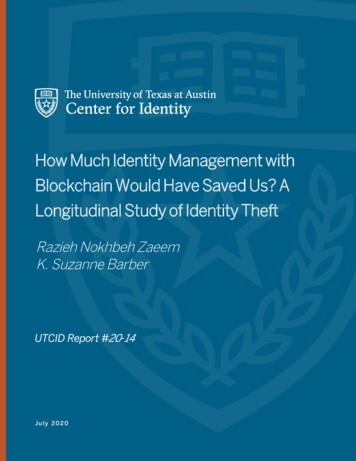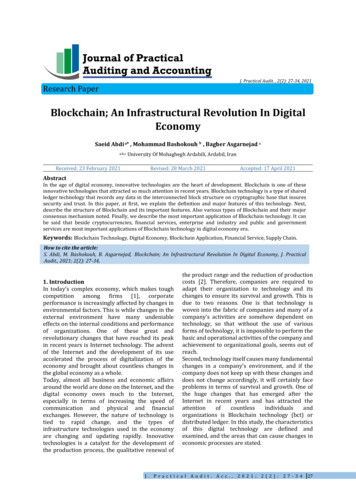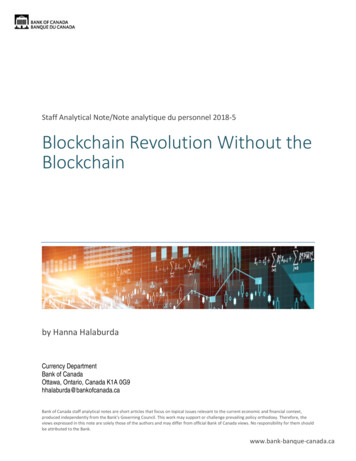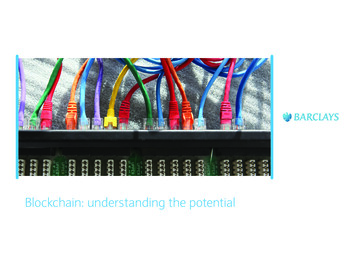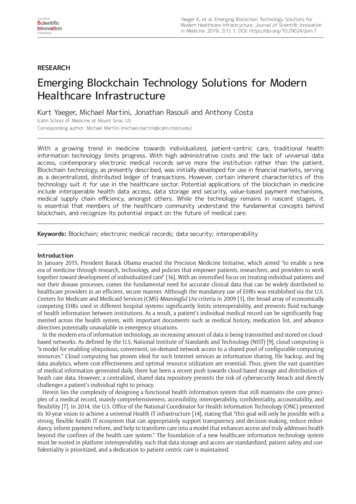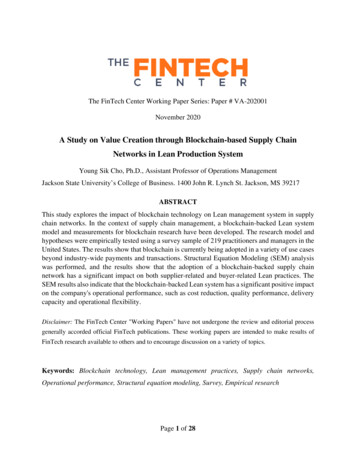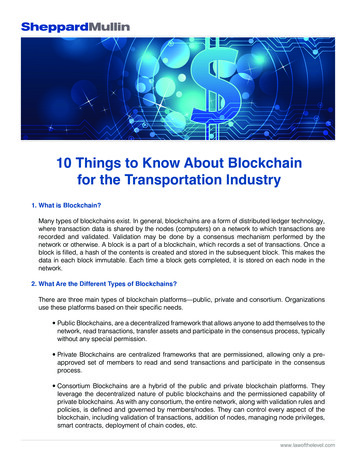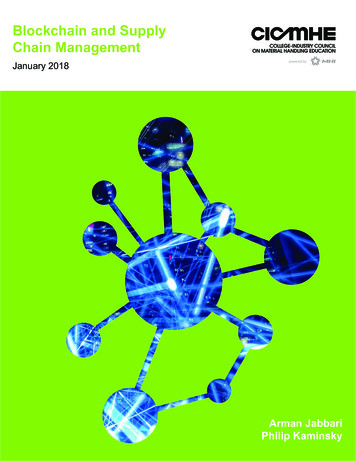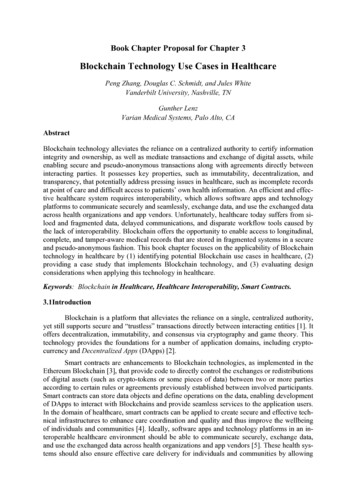
Transcription
Book Chapter Proposal for Chapter 3Blockchain Technology Use Cases in HealthcarePeng Zhang, Douglas C. Schmidt, and Jules WhiteVanderbilt University, Nashville, TNGunther LenzVarian Medical Systems, Palo Alto, CAAbstractBlockchain technology alleviates the reliance on a centralized authority to certify informationintegrity and ownership, as well as mediate transactions and exchange of digital assets, whileenabling secure and pseudo-anonymous transactions along with agreements directly betweeninteracting parties. It possesses key properties, such as immutability, decentralization, andtransparency, that potentially address pressing issues in healthcare, such as incomplete recordsat point of care and difficult access to patients’ own health information. An efficient and effective healthcare system requires interoperability, which allows software apps and technologyplatforms to communicate securely and seamlessly, exchange data, and use the exchanged dataacross health organizations and app vendors. Unfortunately, healthcare today suffers from siloed and fragmented data, delayed communications, and disparate workflow tools caused bythe lack of interoperability. Blockchain offers the opportunity to enable access to longitudinal,complete, and tamper-aware medical records that are stored in fragmented systems in a secureand pseudo-anonymous fashion. This book chapter focuses on the applicability of Blockchaintechnology in healthcare by (1) identifying potential Blockchain use cases in healthcare, (2)providing a case study that implements Blockchain technology, and (3) evaluating designconsiderations when applying this technology in healthcare.Keywords: Blockchain in Healthcare, Healthcare Interoperability, Smart Contracts.3.1IntroductionBlockchain is a platform that alleviates the reliance on a single, centralized authority,yet still supports secure and “trustless” transactions directly between interacting entities [1]. Itoffers decentralization, immutability, and consensus via cryptography and game theory. Thistechnology provides the foundations for a number of application domains, including cryptocurrency and Decentralized Apps (DApps) [2].Smart contracts are enhancements to Blockchain technologies, as implemented in theEthereum Blockchain [3], that provide code to directly control the exchanges or redistributionsof digital assets (such as crypto-tokens or some pieces of data) between two or more partiesaccording to certain rules or agreements previously established between involved participants.Smart contracts can store data objects and define operations on the data, enabling developmentof DApps to interact with Blockchains and provide seamless services to the application users.In the domain of healthcare, smart contracts can be applied to create secure and effective technical infrastructures to enhance care coordination and quality and thus improve the wellbeingof individuals and communities [4]. Ideally, software apps and technology platforms in an interoperable healthcare environment should be able to communicate securely, exchange data,and use the exchanged data across health organizations and app vendors [5]. These health systems should also ensure effective care delivery for individuals and communities by allowing
care providers to collaborate within and beyond organizational boundaries, e.g., by mediatingsecure access to electronic health records (EHRs).Healthcare researchers and practitioners today, however, struggle with fragmented andsiloed data, delayed communications, and disparate workflow tools. On the one hand, providers feel reluctant to exchange data due to (1) perceptions that patient health and identificationinformation safe-keeping regulations prevent such sharing (even anonymized) and (2) potential liability and financial consequences associated with data sharing [6, 7]. On the other hand,vendor-specific and incompatible health systems create gaps in healthcare communications,making it hard to coordinate and provide patient-centric care [8].A key problem in production healthcare systems today is the lack of secure links thatcan connect all independent health systems together to establish an end-to-end reachable network [9] while protecting healthcare professionals with some level of anonymity (privacy).Although data standards like HL7 [10] and FHIR [11] provide basic interoperability for dataexchange between trusted systems, this level of interoperability is limited to the implementedstandards and requires data mapping between systems in most if not all cases. Maintainabilityof these systems is also hard to achieve since an interface change on one system requires otherparties in the trusted network to adapt the change as byDisparateandSiloedSystems1For example, Figure 1depicts barriers to achieving healthcare system interoperability,including incompatible software (such as vendor-locked EHR systems) and the lack of accessto data outside a healthcare environment (such as a firewall protected clinic database or apatient-collected mobile health data). A promising solution to these problems involves theapplication of Blockchain technology, which provides “trustless” transactions viadecentralization with pseudo-anonymity.Complexities within the healthcare industry, however,yield additional challenges to employing Blockchain technology. This book chapter exploresthe fundamental properties of Blockchain technology that can assist in establishing these trusted links and other capabilities in several potential use cases and analyzes the key design considerations for creating production DApps in the healthcare domain.The remainder of this book chapter is organized as follows: Section 3.2 identifiespressing issues in healthcare, focusing on interoperability and patient-centered care; Section1 ker,MetricsforAssessingBlockchain- heIEEEHealthcom2017,October12- ‐15,2017,Dalian,China.
3.3 then describes seven specific healthcare scenarios, or use cases, where Blockchain technology can be leveraged to alleviate some of the major challenges associated; Section 3.4 explores four healthcare-specific challenges faced by Blockchain-based systems and their designimplications; Section 3.5 presents a case study prototype we developed as an example that addresses the challenges; Section 3.6 uses the case study to highlight key design considerationsfor developing Blockchain-based DApps for healthcare; Section 3.7 summarizes key lessonslearned from our experience; and Section 3.8 provides an outlook on future research directionsof Blockchain technology in the healthcare space.3.2Pressing Issues in HealthcareThis section explores pressing issues in healthcare today, focusing on interoperability challenges that limit data sharing and impede patient-centered care fostered by healthcare interoperability that would otherwise allow patients to access and control their own health information.3.2.1 InteroperabilityHealthcare interoperability describes the ability for heterogeneous information technology systems and software applications, such as the Electronic Health Record (EHR) system, to communicate, exchange data, and use the exchanged data [12]. Allowing information systems towork together within and across organizational boundaries is paramount to improve effectivecare delivery for individuals and communities [13]. For example, interoperability enables providers to securely and scalably share patient medical records with one another (given patientpermissions to do so), regardless of provider location and trust relationships between them.Secure and scalable data sharing is essential to provide effective collaborative treatment and care decisions for patients. Data sharing helps improve diagnostic accuracy [14] bygathering confirmations or recommendations from a group of medical experts, as well as preventing inadequacies [15] and errors in treatment plan and medication [16, 17]. Likewise, aggregated intelligence and insights [18-20] helps clinicians understand patient needs and in turnapply more effective treatments. For example, groups of physicians with different specialtiesin cancer care form tumor boards that meet regularly to discuss cancer cases, share knowledge,and determine effective cancer treatment and care plans for patients [21]. As another example,if a cancer patient under treatment is admitted to the emergency room (ER) in a different hospital, then it would be critical for the ER provider to access the patient’s medical records toidentify potential drug interactions; while the patient’s primary cancer care provider should benotified that the patient is being treated in the ER.Despite the importance of medical data sharing, today’s healthcare systems frequentlyrequire patients to obtain and share their own medical records with other providers either viaphysical paper copies or electronic hard disk copies. This process of obtaining and sharingmedical records is ineffective for the following reasons: It is slow since copies of medical data must be prepared, delivered, and picked up by patients. The law allows providers up to 30 days to supply medical records to patients, although some providers may only take 5-10 business days to prepare non-critical health records [22]. It is insecure because data copies may be lost or stolen during their physical transmissionby patients from one location to another. It is incomplete since as patient health history may be fragmented because their data isstored in disparate and siloed systems. There is no single source that stores all the medicalrecords of an individual, so patients must therefore be responsible for keeping track of
when and where they received health services in order to request copies of their medicalhistory. It lacks context since today’s healthcare systems are provider-centric instead of patientcentric, thereby preventing patients from taking control of their own health records andhaving knowledge of what is done to their data or who has accessed their data [23].The ineffective data sharing process in healthcare results in part from the lack of trustbetween providers and the lack of interoperability between health IT systems and applicationstoday. Healthcare interoperability comprises of three levels: foundational, structural, and semantic, ordered lowest to highest fidelity [24], as summarized in Table 1 and described lityInteroperability LevelSummaryFoundationalData exchange is enabled; does not require data interpretationStructuralDefines formats for the exchanged dataSemanticRequires interpretation of the exchanged dataFoundational interoperability enables data exchanges between healthcare systems. Itdoes not require providers receiving the data to be able to interpret the data. Structural interoperability additionally defines formats for exchanged clinical data and ensures that received data are preserved and can be interpretable at the data field level using predefined formats. Semantic interoperability demands the interpretability of exchanged data by not onlysyntax (structure) but also semantics (meaning) of the data.These three levels help ensure that disparate health systems and applications deliverinformation with requisite data quality and safety. Foundational and structural interoperability are prerequisites for semantic interoperability, which is hardest to achieve but most desired to advance quality of care. This book chapter focuses on exploring Blockchain-baseduse cases that address foundational and structural interoperability from the technical infrastructure’s perspective. Semantic interoperability requires clinical domain knowledge andmedical policies that enforce the adoption of ontologies, i.e., common data standards, to interpret myriad sources of health information, which is beyond the scope of this book chapter.3.2.2 Patient-Centered CareThe healthcare industry is shifting from volume-based care (fee-for-service), in whichproviders are incentivized to provide more treatments because payment is proportional to thequantity of care, to value-based care that promotes patient-centered care with higher quality(hence “value”), in which patients are informed and involved in clinical decision making[25]. In patient-centered care model, patients are capable of incorporating Patient ReportedExperience Measures (PREM) and Patient Recorded Outcome Measures (PROM) [26], suchas symptoms or health status, collected from their wearable and mobile devices into theirmedical history. Patients should also be given easy access to their medical records with acomprehensive view of their entire health history, which could potentially reduce informationfragmentation and inaccuracy caused by communication delays or coordination errors and inturn improve the care continuity and quality [27].Ideally, all health systems (regardless of the type of care settings) would provide automatic notifications for patients to access their clinical data in (near) real-time, e.g., as records are entered into the system or when lab results are available. In addition, in patientcentric care it is necessary for patients to control when and to whom their health data isshared and to choose what pieces of information they would be willing to share. Healthcare
systems today, however, do not provide the means for patients to modify or revoke a provider’s access to their data.As a result, once a provider has cared for a patient or has obtained access to patientdata that data is permanently in possession of the provider. When a patient visits differentproviders many times throughout their lifetime, their health and other sensitive personal datais available at several sites. This diffusion increases the risk of data theft because it only takesone provider lacking sufficient and up-to-date security practices to put patient informationvulnerable to attack (with the assumption that no malpractice or unethical usage of patientdata is involved, of course). Alternately, a patient may wish to release their medical recordsto a new provider, which is not easily accomplished today as discussed in Section 3.2.1above.Interoperability is also fundamental to support a patient-centric model that improvesquality of care for individual patients. In practice, barriers exist in the healthcare technicalinfrastructure that impedes interoperability and thus patient-centered care, including (but notlimited to): Information security and privacy concerns. Despite the need for data sharing, it increases the risk of sensitive data breaches without a highly secure infrastructure in place[7]. Providers could face severe financial and legal consequences [6] when data is compromised. Lack of trust between providers. Because of security regulations, care providers mustbe able to identify other providers and also trust their identities before any patient healthrelated communication occurs [28]. Trust relationships often exist between in-networkproviders and/or health organizations but they are particularly difficult to establish whenthe data receiving care office does not use the same health system with a shared providerdirectory, such as in a private practice or a hospital network. Scalability concerns. Medical data may contain large volumes of data like medical images, especially in cancer patients or patients with chronic conditions. These large-scaledatasets are difficult to share electronically due to limitations in bandwidth or restrictivefirewall settings, such as in rural areas [29].Below we first present six potential use cases of Blockchains in the healthcare spaceand then focus on a concrete case study that demonstrates what design decisions can be madeto leverage Blockchain-related technologies to address these interoperability challenges.3.3 Blockchain Use Cases in HealthcareThis section explores seven Blockchain use cases focusing on various concerns in healthcare,as summarized in Table kchainTechnologyCanAddressSectionUse Case Summary3.3.1Prescription Tracking to Detect Opioid Overdose and Over-Prescription3.3.2Data Sharing to Incorporate Telemedicine with Traditional Care3.3.3Sharing Cancer Data with Providers Using Patient-Authorized Access3.3.4Cancer Registry Sharing to Aggregate Observations in Cancer Cases3.3.5Patient Digital Identity Management for Better Patient Record Matching3.3.6Personal Health Records for Accessing and Controlling Complete Health History3.3.7Health Insurance Claim Adjudication Automation to Surface Error and Fraud
3.3.1 Opioid Prescription TrackingIt is widely known that there is an opioid epidemic present in the United States [30]. Whilemany efforts are being made to address this crisis (e.g., the Drug Supply Chain Safety Act(DSCSA) [31], the President’s Commission on Combating Drug Addiction and the OpioidCrisis [32], and numerous prescription awareness campaigns [33, 34]), our current prescription tracking system still lacks the technology to do so effectively. Data hoarding, doctorshopping [35], provider ignorance, vulnerable and centralized data, and over-prescription riddle the current prescription opioid marketplace. The decentralization and auditability ofBlockchain technology provides a promising approach to prescription monitoring that notonly makes prescriptions safer, but also provides incentives for writing fewer prescriptions.Healthcare providers today are incentivized to prescribe opioids to patients. For example, providers incur less face-time with patients, fewer costs associated with patient care,and thus greater profits from higher returns. Likewise, pharmacies are incentivized to produceand distribute opioids since the more they sell, the higher their bottom line and the greatertheir return to shareholders. Moreover, patients are incentivized to consume opioids. In thetreatment of pain, physical therapy or post-surgery recovery can be frustrating and riddledwith disappointment [36]. Opioids provide a short-term relief, at the cost of addicting a patient. This self-fulfilling cycle can thus benefit from a technological solution that realigns these incentives.To offset these incentives contributing to the rise of the opioid epidemic, a Blockchain-based system can establish a trusted network of hospitals and pharmacies to store opioid-associated transactions (including prescriptions, fulfillment, etc.) in a secure and accountable manner. Such a distributed and shared permissioned Blockchain platform allows forloosely-coupled providers to access other data silos without explicit trust relationships between each other. Stakeholders within the system (hospitals, pharmacies, etc.) are likewiseincentivized to onboard new members to the consortium because with each additional member, they can form a more complete dataset. Rules can be mutually predefined so the consortium can securely onboard new provider members to the system.By distributing knowledge that an opioid transaction has occurred, rather than the entirety of the specific content of that transaction, this type of ecosystem can remedy a numberof the problems in the current opioid system. More complete opioid prescription history canbe available to detect overly prescribed opioid by providers and also patterns of doctor shopping in patients. Consequently, providers will be incentivized to meet the requirements to jointhe consortium of providers through potential access to data that will increase the quality oftheir care. Most importantly, by tracking the history of opioid prescriptions, patients will receive care more appropriate to their condition and thus be steered away from the dangers ofopioids towards less addictive and thus longer lasting treatment actions.3.3.2 Data Sharing between Telemedicine and Traditional CareTraditionally, telemedicine offers widely accessible care to patients who are located inremote areas far away from local health facilities or in areas of with shortages of medicalstaff. Today, it has becoming increasingly popular among patients who wish to receive convenient medical care [37]. Connected patients can avoid wasting time waiting at a doctor’soffice and get immediate treatment for minor but urgent conditions on demand [38]. Due tothe growing accessibility to smart mobile and telemedicine devices, many companies offer24/7 continuous access to care, and many user-friendly apps have been created for patients tomonitor, manage, and report their health using technology [39]. For example, Apple Health
[40] app allows patients to connect to equipment for measuring vitals and store these data ontheir iPhones . These records can then be reported to the provider as needed.Telemedicine services are usually equipped with more advanced technologies and aremuch more far-reaching compared to traditional physical health services. Due to these ondemand services, it is common for providers from different regions or networks to treat patients, resulting in reduced care continuity. Health data collected during telemedicine careepisodes may be inaccessible by patients’ primary care providers, which creates an incomplete medical history and in turn risks the overall quality of care [41].By removing the need for a third-party authority and empowering direct interactionsbetween involved participants, Blockchain technology can potentially bridge the communication barrier between these providers. Blockchain technology alone, however, cannot addressthe complex data sharing challenge–it must be incorporated into existing disparate health systems and clinical data standards. Figure 2 shows a high-level conceptual infrastructure wherea Blockchain (represented as the dashed ellipse) is connected to disparate health database systems (represented as cylinder database objects).Each database system shown in Figure 2 opens up a new secure data channel (as representedby small circles on the ellipse border), similar to what is used to share data with other akinsystems. A smart contract (the keyed file symbol) is then used to govern the data transactionsbetween these systems based on mutual agreements and also create an immutable history ofall the transaction records. In practice, a robust architecture will include many more designcomponents than what is shown in Figure 2.Figure2AHigh- ‐LevelBlockchain- .3.3 Patient-Controlled Cancer Data SharingCancer diagnoses and treatment plans are rarely black-and-white, i.e., they involvemany considerations due to the complexity of tumor cases and the number of available treatment options [42]. Getting fresh perspectives from different specialists can help narrow downthe options and may shorten the time from (suspected) diagnosis to treatment for a cancer patient. In the U.S. today, most hospitals have included at least one tumor board, which is amultidisciplinary team of medical, surgical, radiation oncologists, and other specialists andcare providers, to review and discuss individual cancer patient’s condition and treatment options in depth [2]. Despite the increasing effort to encourage cancer care collaboration amongoncologists, patients and families remain passive in the decision-making process. A largescale enterprise hospital may involve specialists from a wider range of disciplines, whereas asmaller-scale care center may have limited resources to expand their tumor boards. The quality of life that is important to cancer patients may be neglected due to patient disengagement.
In reality, patients may wish to reach out to a new provider for a second opinion ontheir medical conditions and/or treatment plan. To share critical data today, patients have toobtain copies of their medical reports from their current provider, which may include theirfamily history, visit history, prescriptions, current diagnoses and treatment options, and so on.All reports will then be delivered physically to the new provider. In this technologically advanced society, patients with critical conditions should be least involved in the manual datasharing process and have the critical data shared in a timely manner to prevent delays intreatment. A patient-controlled data sharing feature is missing from the existing health systems for cancer patients to promptly request a second opinion and also selectively share information.Instead of creating a new trusted “middle man” that mediates the establishment oftrust relationships between providers/hospitals, Blockchain technology offers the opportunityfor trustless exchange and disintermediation that allow existing trust relationships to be aggregated and propagated across various organizations and providers. This approach is similarto the patient referral process, except the referrals are not limited to a single provider’s network. Instead, they could be expanded across different regions, states, and even countries. ABlockchain-based system can also capture existing trust relationships between patients andproviders, allowing patients to decide which provider(s) can share their data.3.3.4 Cancer Registry SharingData sharing is especially critical in cancer care where cases are usually complex andcures are rarely one-size-fits-all [43]. Being able to share cancer data helps ensure the integrityof results obtained from clinical trials by enabling individual confirmation and validation, butit can also agglomerate intelligence gathered to reduce unwarranted repetition in clinical trials[18-20]. It allows distributed clinical trials to achieve a significant cohort size and thus speedsup the discovery of more effective cancer treatments. In the U.S., only about 3% [44] of cancer patients are undergoing clinical trials today. As a result, most cancer patients receivetreatments based on observations drawn from this small population of highly selective patientswith different demographics, family medical history, secondary diagnoses, etc.Population-based cancer registries (PBCR) are attempts to capture very rudimentarydata from cancer incidences across geographic areas and for planning population-wide cancercontrol [45]. As with EHRs, cancer registries are often siloed and fragmented, which can similarly leverage Blockchain technology for expedited information exchange. In addition, withincreased availability of richer data collected from many patients, artificial intelligence can beused to construct prognostic and predictive models for assisting care providers with decisionsupport. A learning ecosystem can be designed using Blockchain technologies to also sharepredictive models and collaboratively improve accuracies of learned medical insights.3.3.5 Patient Digital IdentityA fundamental component in health information exchange is patient identification [46]matching, which finds a patient in a healthcare database using a unique set of data. Systemslike the Master Patient Index (MPI) and Enterprise Patient Master Index (EPMI) [47] havebeen created to manage patient identities within a healthcare organization or within a trustednetwork. Despite the increased development effort, accurately and consistently matching patient data remains hard. Patient identity mismatching has contributed to duplicated patientrecords and incomplete or incorrect medical data [48].One study [49] estimated that 195,000 deaths occur each year due to medical errors,with 10 of 17 errors being identity or “wrong patient errors.” There are also significant coststo healthcare organizations who maintain these duplicate records and correct mistakenly
merged errors [50] and also patients who experience repeated tests or treatment delays. Inaddition, these errors also impact reimbursement as claims may be denied due to “out of dateor incorrect information” [51], not to mention the security risks involved when patients disclose their personal information.Without common standards for collecting patient identifying information, even thesame patient’s identity can vary from one care facility to another. For instance, demographicsdata, such as name, date of birth, address, and Social Security Number (SSN) are often usedto register a patient [46]. However, names may be stored in various formats, such as legalfirst and last name, nickname and last name, with or without middle initial, and patients mayshare identical or similar names; similarly, date of birth can be entered into the system inmultiple ways; address can change as patients move to a new location; and patients may refuse to provide their SSN or do not have an SSN. Furthermore, patient information manuallyentered into the system may contain typos or errors, and the more data collected, the moreopportunities for mistakes [51]. Although within each organization patient demographics datamay be collapsed into a single unique ID, the ID generally does not translate across organizations.Without a functional, unified identity management system, patient identificationschemes employed at various care sites may continuously experience incompatibility and patient matching problems, unless a patient exclusively receives care within one organization.In fact, the very nature of Blockchain incorporates such a decentralized, unified identity system. Many existing Blockchains use cryptographically secured addresses to represent identities. Each address is mathematically linked with a unique key that is used to easily verify theownership of an address or an identity yet does not reveal any personal information relatingto the individual. The decentralized and auditable characteristics of Blockchain can help enforce standardized verifiable identities for patients via a universal
and pseudo-anonymous fashion. This book chapter focuses on the applicability of Blockchain technology in healthcare by (1) identifying potential Blockchain use cases in healthcare, (2) providing a case study that implements Blockchain technology, and (3) evaluating design considerations when applying this technology in healthcare.

